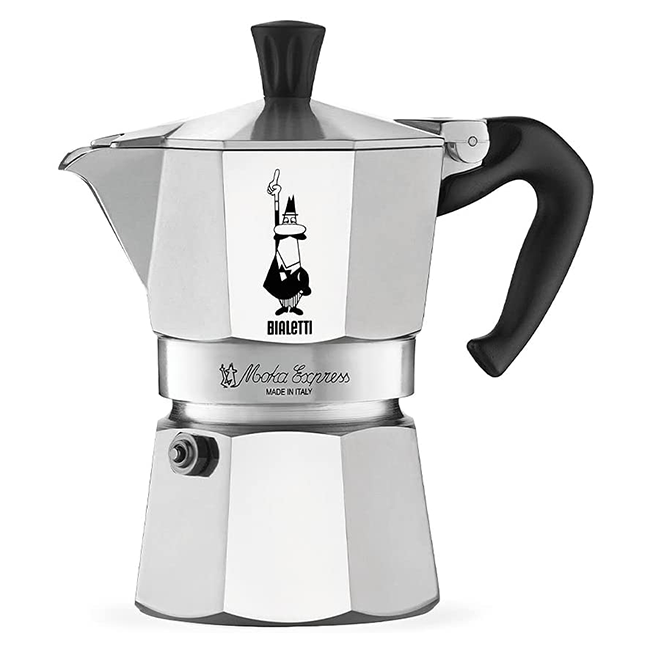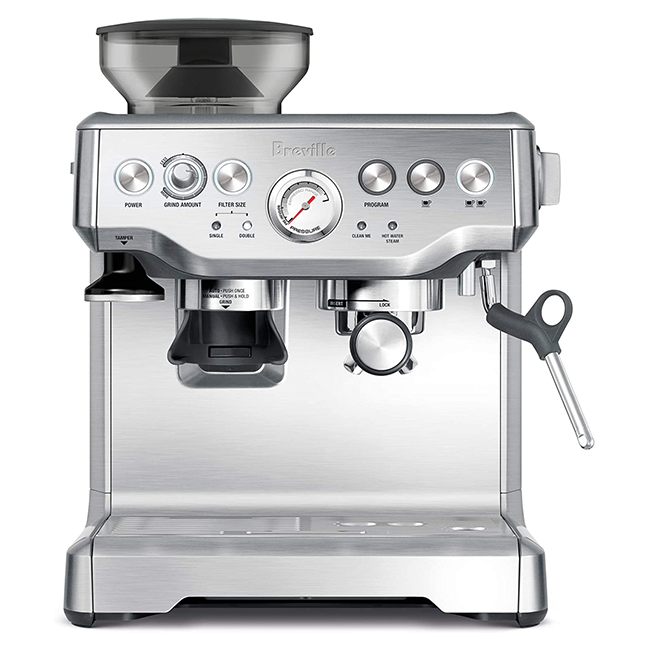Speak to any experienced barista and they’ll likely tell you that the only true and most effective way to brew coffee is with an espresso machine. The pressure, they will argue, is unbeatable for drawing out the natural flavor profiles of the bean in a timely way without over extracting it. Other camps, however, will die on their hill arguing that there is no replacement for the Moka pot. Its ease of use, affordability, and general durability make it a firm favorite for coffee lovers all over the globe.
In an effort to answer the question of which one is best, we’re going to do a deep dive into both techniques to determine which makes the best coffee, and which is better value for money.
The Moka Pot
The Moka Pot is one of the most common methods for brewing coffee worldwide. It is used cross-culturally in households in almost every country in the world and is praised for its affordability, ease of use, and ability to brew strong-bodied and delicious coffee.
The device consists of three chambers that fit into each other. The bottom chamber holds the water, the middle part is the filter basket which holds the coffee grounds, and the top chamber collects the final product once it has finished brewing. Once the Moka pot is prepared and assembled, it is placed over a heat source that will boil the water in the bottom chamber. As the water turns into steam, the pressure forces it through the filter basket and the ground coffee into the upper charmer. During the process, the steam extracts the coffee grounds, cools into back into a liquid (albeit a hot one), and gathers into a concentrated coffee in the top chamber.
How to use a Moka pot correctly
- Start by disassembling the entire device so that you can find the interior filter basket.
- Fill the bottom chamber up with water until it’s just below the pressure-release valve. Make sure that you don’t fill up past this point, so you risk creating so much pressure that Moka pot could explode (no jokes here, this is why the valve exists in the first place).
- Add your coffee. We recommend using a medium-to-medium fine grind for any sort of Moka pot. Make sure that it’s coarser than the grind you would use in an espresso machine but finer than you would use in a drip coffee maker. If it’s too fine, you risk clogging your filter basket and an inconsistent extraction. In terms of weight, about 18 grams of coffee is a good amount for a 3-cup Moka pot. Make sure that you don’t tamp the ground coffee as this will result in an uneven extraction as there isn’t enough pressure to force the water through.
- Assemble your Moka pot by placing the filter basket into the water chamber, and then screwing on the top chamber, then place it on your heat source.
- After a few minutes, water will start making its way into the top chamber and you should see your final brew start to accumulate in the top chamber. Once you hear a gurgling sound, turn off your heat stove and move the Moka pot to a different surface. If you leave the Moka pot on the heat source, it might burn your coffee and leave you with a horrible bitter taste.
Pros
- Makes a rich, thick, and strong coffee
- The aluminum body helps to retain heat
- Easy to clean
- Portable
- Cheap
Cons
- Requires a good burr grinder to produce a fine texture
- Difficult to control quality from brew to brew
- Lacks pressure required to create authentic espresso with crema
The Espresso Machine
Using an espresso machine to make coffee is a bit more of a complicated affair than using a Moka pot. Whereas a Moka pot requires nothing more than a heat source in order to work, an espresso machine is a complicated configuration of motors, boilers, and working machinery.
In general, an espresso machine is comprised of three main components: the water boiler, the group head, and the portafilter. The water boiler is a pretty straightforward piece of kit and does exactly what it sounds like: it boils water. The group head is responsible for controlling the pressure and water flow that gets pushed through the ground coffee and filter basket. It is the heart of the espresso machine and is usually located on the front of the espresso machine. A group head goes by a few different names, and might simply be called the “group”, “brew group” or “brew head.” And finally, the portafilter is a filter-basket attached to a handle that holds the ground coffee in place while hot, pressurized water is forced through it. It snaps onto the front of the espresso machine and can quickly be unsnapped, emptied, and refilled to pull the next shot of espresso.
Espresso machines are lauded for their ability to be able to extract coffee from grounds extremely quickly; it usually takes less than a minute. They’re also able to generate much more pressure than a Moka pot. While Moka pots can generate between 1 and 2 bars of pressure, espresso machines generate a minimum of 9, and it’s not uncommon for an espresso machine to generate up to 15. This pressure does two things. As stated above, it means that espresso can be brewed quickly, but it also allows you to achieve a crema – the luxurious, creamy head of an espresso shot that many connoisseurs look for and believe is the indicator of an espresso shot’s quality.
Pros
- Is able to extract a super-concentrated shot of coffee
- Is able to achieve a luxurious crema
- Can brew a shot of espresso in less than a minute
- The water boiler can be also be used for steam wand in order to create different coffee drinks
- Can pull multiple shots of espresso simultaneously
Cons
- Requires a lot of extra equipment – grinder, scale, and tamper
- Has a bit of a steep learning curve; getting good with an espresso machine requires some practice or training
- Expensive – a good espresso machine will set you back anywhere from $300 – $1500
- Can be a bit of a nightmare to clean up
Moka Pot vs Espresso: Key Differences
- A Moka pot uses nothing more than a heat source to brew coffee. An espresso machine uses a complex configuration of motors, boilers, and working machinery.
- A Moka pot makes delicious and concentrated coffee, but it can’t quite be called espresso. It is very easy to over- or under-extract the coffee made with a Moka pot. An espresso machine, on the other hand, makes a much more concentrated and intense espresso shot. Due to it being powered by machinery and electronics, it’s also very easy to achieve a consistent result every time.
- A Moka pot can generate between 1 and 2 bars of pressure. An espresso machine can generate between 9 and 15.
- A Moka pot can only brew one serving of coffee at once. An espresso machine can brew multiple shots of espresso simultaneously depending on how many portafilters it has.
- An espresso machine makes “true espresso” in the sense that it can produce a crema, whereas a Moka pot can’t.
Moka Pot vs Espresso: What They Have In Common
- Both the Moka pot and espresso make delicious, concentrated coffee.
- Both rely on heat and pressure in order for extraction.
- Both are championed by baristas around the world, albeit for different reasons.
Buy A Moka Pot: Our Top Pick
We’ve written a lot about Moka pots in the past and have looked in detail at the best Moka pots currently available on the market. As stated in the article, the best Moka pot by far that money can currently buy is the Bialetti Moka Express.

Since 1950, Bialetti has consistently proved itself as one of the best companies in the world when it comes to the manufacturing of premium coffee equipment, and its flagship model – the Moka Express – is exemplary in this regard. Featuring a classic design that is both attractive and recognizable no matter where in the world you find yourself, the Moka Express not only makes delicious brew but looks fantastic in any home or cafe. It’s designed to distribute heat evenly during brewing in order to extract coffee evenly and consistently. It’s also available in a number of different sizes; the link above is for the 3-Cup version, but if you need a bit more of a heavy-hitter, you can also pick up the Bialetti Moka Express in a 6-cup version.
Compatible with most stoves, the only true drawback to the Moka Express is its construction material. Made almost entirely from aluminum, it won’t last as long as a stainless steel counterpart.
Buy Espresso Machine: Our Top Pick

If you’re looking for an espresso machine that does everything and then some, look no further than the Breville Barista Express. Constructed from stainless steel, the Barista Express has a premium feel straight out of the box and will look amazing in any cafe or kitchen. It comes standard with a single portafilter capable of holding between 19g and 22g of coffee and can produce two delicious, creamy shots of espresso simultaneously.
This machine gives you full control over the brewing process thanks to its digital temperature control technology which precisely maintains the ideal water temperature for a perfect extraction. It’s able to achieve this by pre-infusing the grounds and then forcing through hot water using 9 bars of pressure.
Other features world mentioning include the built-in conical burr grinder. Simply add your favorite beans to the hopper, select the desired grind size by using the dial on the front of the espresso machine, then receive freshly ground coffee right into your portafilter. No espresso machine would be complete without a steam wand, and the Breville Barista Express is no exception. Using the same pressure used for the espresso, the steam wand allows you to hand-texture microfoam milk for your favorite lattes and cappuccinos.
Moka Pot FAQs:
Should you tamp the grounds in a Moka pot?
While you might be tempted to tamp the grounds in the Moka pot similarly to how you would in a portafilter, the answer is actually no. Because the Moka pot can’t generate the same amounts of pressure as an espresso machine, water won’t be able to be pushed through effectively into the top accumulating chamber. This will result in a slow and over-extracted final brew.
How long does a Moka pot take to brew?
A Moka pot should take anywhere between 5 – 10 minutes to brew depending on how hot or cold the water was when you initially added it to the bottom chamber. Unlike other brewing methods like the French press, however, you don’t have to rely on a timer to get it right. Just listen out for the gurgling sound that occurs near the end of the brewing process, and then take the Moka pot off the heat.
Can a cheap espresso machine still pull a decent shot of espresso?
There’s nothing wrong with a cheap espresso machine if you’re just starting out on your coffee-making journey, but don’t be fooled – it won’t be able to pull a shot of espresso that tastes as good as a premium model. If you’re interested in pulling the best shot of espresso possible, then it’s definitely worth spending a bit more money on your espresso machine.

